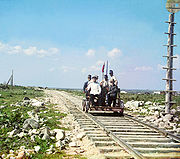
Rail push trolley
Encyclopedia


Rail tracks had a tendency to develop various defects including cracks, loose packing etc, which may lead to accidents. The first rail inspections were done visually. Push trolley inspections formed a very important part of these visual inspections. Although many railways in the world have switched to other methods of inspection, it is still widely used over Indian Railways
Indian Railways
Indian Railways , abbreviated as IR , is a departmental undertaking of Government of India, which owns and operates most of India's rail transport. It is overseen by the Ministry of Railways of the Government of India....
in addition to other techniques, especially for inspecting railway track and assets like bridges which are situated between stations. The push trolley carries one or more officials inspecting the track and the railside equipment. The official carries instruments to measure and check the condition of the tracks and monitor the work being done by the trackmen, keymen, gatemen etc who maintain, patrol, man the track and installations. The push trolley also used by officials inspecting signalling installations in some parts of India. On routes carrying high volumes of traffic, such as the suburban section in Mumbai, push trolleys cannot be used and foot inspections are being resorted to. Push trolleys have a major advantage over motorised trolleys as these do not require any traffic block and the inspecting officials can carry out inspections at their leisure. The push trolleys are a potential safety hazards as these occupy track (albeit temporarily) and if the trolley is not removed from track in time, the same can collide with train and cause accidents. Therefore, on sections having gradients or poor visibility, the push trolleys are not allowed without traffic blocks. '
See also
- Rail inspectionRail inspectionRail inspection is the practice of examining rail tracks for flaws that could lead to catastrophic failures. According to the United States Federal Railroad Administration Office of Safety Analysis, track defects are the second leading cause of accidents on railways in the United States. The...
- Maintenance of way
- Nondestructive testingNondestructive testingNondestructive testing or Non-destructive testing is a wide group of analysis techniques used in science and industry to evaluate the properties of a material, component or system without causing damage....
- Rail tracks
- Track checkerTrack checkerA track checker is a small railway carriage used in the United States and Ireland to audit the gauge and integrity of railway tracks. The first track checkers were simply people that walked the tracks, making sure that the tracks were not damaged and that the switches were working. These people...
- HandcarHandcarA handcar is a railroad car powered by its passengers, or by people pushing the car from behind. It is mostly used as a maintenance of way or mining car, but it was also used for passenger service in some cases...
- DraisineDraisineA draisine primarily refers to a light auxiliary rail vehicle, driven by service personnel, equipped to transport crew and material necessary for the maintenance of railway infrastructure....

